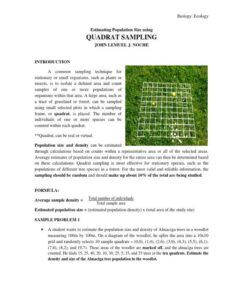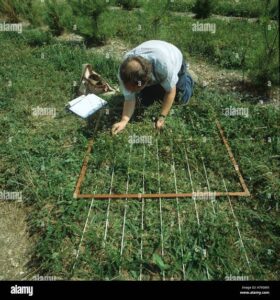Back to: ZOOLOGY 500 Level
Welcome to class!
Hey there, superstar learner! It’s always a pleasure to have you back in class. Today, we’re stepping into a core ecological skill that every serious zoologist must master—estimating population size and density. Whether you’re working in the tropical rainforests of Cross River, the savannah grasslands of Taraba, or the freshwater swamps of the Niger Delta, understanding how to measure the number of animals in a habitat is key to protecting species and managing ecosystems effectively.
Estimating Population Size And Density
What is Population Size and Density?
Population size refers to the total number of individuals of a species in a specific area. Population density, on the other hand, is about how closely packed or spread out those individuals are—it is the number of individuals per unit area (like per square kilometre or hectare).

Think of it like this: if you’re counting elephants in Yankari Game Reserve, population size is how many elephants there are in total. Population density is how many elephants are found per square kilometre of the park.
Why Do We Estimate Populations?
It’s not always possible to count every single animal, especially when they’re fast, secretive, or live in large, wild areas. That’s why scientists use sampling methods to estimate. Knowing population size and density helps with:
Conservation planning (e.g. preventing extinction)
Resource management (like setting hunting or fishing limits)
Studying population trends over time
Assessing habitat quality and carrying capacity
Methods of Estimating Population Size
Quadrat Sampling
Used for plants or slow-moving animals. A quadrat is a square frame placed randomly in the habitat. You count the number of individuals within the square, and then multiply based on how many quadrats would fit into the whole area.
For example, in a wetland in Ogun, if you find 10 frogs in 1 square metre, and the wetland is 1,000 square metres, an estimated 10,000 frogs might be present.
Mark-Recapture Method
Useful for mobile animals like rodents, lizards, or small mammals. Here’s how it works:
Capture a number of animals.
Mark them in a harmless way (like a coloured tag).
Release them.
After a few days, capture again.
Use the formula:
Estimated Population (N) = (M × C) / R
Where:
M = number initially marked
C = total number captured the second time
R = number of marked individuals recaptured
For example, if you mark 50 rats, later capture 40, and 10 are marked, then:
N = (50 × 40) / 10 = 200 rats.
Direct Counts and Aerial Surveys
In open habitats like savannahs or national parks, researchers may use binoculars, drones, or helicopters to count visible animals like antelope or buffalo. This method is expensive but effective in large areas.
Factors That Affect Accuracy
Weather and time of day (animals may hide or move)
Observer skill
Animal behaviour (some avoid humans)

Re-sampling too soon (marked animals may not have mixed well with the population)
Real-Life Nigerian Example
In Okomu National Park, conservationists used both camera traps and mark-recapture to estimate the duiker antelope population. Their findings helped design protected zones and anti-poaching patrols to keep the animals safe.
Summary
- Population size is the total number of individuals; density is per unit area.
- Common methods include quadrat sampling, mark-recapture, and direct counts.
- These estimates guide conservation, wildlife management, and policy decisions.
- Good planning and accurate sampling are vital for reliable results.
Evaluation
- Differentiate between population size and population density.
- Describe how the mark-recapture method works.
- In a forest, you marked 80 monkeys. Later you capture 60, and 20 are marked. Estimate the population size.
- What are two challenges that can affect the accuracy of population estimates?
You’re mastering tools that real scientists use to protect life! This knowledge will make you a voice for wildlife and a leader in African conservation. Keep shining, and remember—Afrilearn is always by your side as you journey towards greatness!
